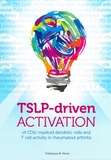TSLP-driven activation of CD1c myeloid dendritic cells and T cell activity in rheumatoid arthritis

Moret, Fréderique
- Promoter:
- Prof.dr. F.P.J.G. (Floris) Lafeber & prof.dr. J.W.J. (Hans) Bijlsma
- Co-promoter:
- Dr. J.A.G. (Joel) van Roon
- Research group:
- Lafeber
- Date:
- May 8, 2014
- Time:
- 12:45 h
Summary
Rheumatoid arthritis (RA) is characterized by joint inflammations that is dependent on CD4 T-cells producing Th1 and Th17 cytokines. Activation and differentiation of CD4 T-cells to become Th1 or Th17 cells is regulated by dendritic cells. CD1c (BDCA-1) myeloid dendritic cells (mDCs) have a strong capacity to activate CD4 T-cells. The aim of this thesis was to investigate the inflammatory potential of thymic stromal lymphopoietin (TSLP) to activate natural occurring CD1c mDCs and subsequently the regulation of CD4 T-cell responses in RA as well as the capacity of T-cell-targeting therapy (abatacept) to influence TSLP-driven immunopathology in RA. Compared with CD1c mDCs from peripheral blood (PB), increased numbers of intra-articular CD1c mDCs expressed an activated phenotype and secreted a unique set of T-cell-attracting chemokines and spontaneously induced Th1, Th17, and Th2 cell activity. TSLP levels were significantly increased in synovial fluid (SF) of RA patients versus osteoarthritis patients. TSLP selectively stimulated production ofT-cell-attracting chemokinesas well as TNFα by CD1c mDCs. TSLP-primed mDCs from PB and SF potently stimulated proliferation of autologous CD4 T-cells compared with unstimulated mDCs. Enhanced proliferation was associated with increased Th1, Th17, and Th2 cell activity. TNFα produced by TSLP-stimulated mDCs inhibited Th2 responses by favouring Th1-attracting chemokine production and preventing T-cells to secrete Th2 cytokines. Considering the immunoregulatory capacity of Th2 cells in RA this suggests that TNFα might contribute to TSLP-induced immunopathology in RA. Activation of PB-derived naïve and memory T-cells by (TSLP-primed) mDCs was completely blocked by the anti-rheumatic drug abatacept. IL-7 strongly increased T-cell activation and overruled the inhibitory capacity of abatacept. Similarly, CD4 T-cell proliferation induced by TSLP-primed mDCs from SF of RA patients, mainly consisting of memory T-cells, was strongly blocked by abatacept and vigorously overruled by IL-7. This indicates that the presence of T-cell-activating cytokines, like IL-7, in RA joints reduce the inhibitory capacity of abatacept on mDC-driven T-cell activation that might explain lack of response to abatacept therapy. In contrast to PB-derived T-cells, an evident hypo-responsiveness of SF-derived CD4 T-cells upon (TSLP-primed) mDC activation was observed and we investigated the involvement of inhibitory PD-1/PD-L1 interactions. Synovial T-cell hypo-responsiveness upon (TSLP-primed) mDC stimulation in RA joints was partially dependent on PD-1/PD-L1 interactions as PD-1 and PD-L1 were highly expressed on synovial T-cells and mDCs, respectively, and PD-1 blockade during memory T-cell and (TSLP-primed) mDC cocultures from RA patients significantly enhanced but not fully recovered T-cell proliferation. The potential of IL-7 to overrule this hypo-responsiveness suggests that such proinflammatory cytokines in RA joints strongly contribute to memory T-cell activation. Finally, we described that levels of the naturally occurring soluble IL-7Rα (sIL-7Rα) were strongly increased in SF of RA patients compared with osteoarthritis patients and correlated with markers of inflammation. Increased sIL-7Rα might be associated with an increased IL-7-driven immune activation. This thesis demonstrates an important role for in vivo activated CD1c mDCs to drive T-cell activation in RA and that prevention of TSLP- and IL-7-driven mDC/T-cell activation seem to have therapeutic potential.